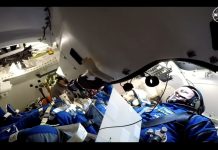Oct. 21 (UPI) — NASA’s OSIRIS-REx touched down on asteroid Bennu on Tuesday evening in a mission to scoop a sample of rocks and dirt.
The spacecraft — the Origins, Spectral Interpretation, Resource Identification, Security, Regolith Explorer — made soft contact with the asteroid at 6:12 p.m. EDT.
The historic “touch and go” event featured animation displaying OSIRIS-REx’s sample collection activities in real time. It takes time for real images of the touchdown to travel back to the Earth, so they won’t be released to the public until Wednesday.
The craft executed a series of maneuvers over the course of several hours before making soft contact with the surface of the asteroid to collect regolith, or rocks and dirt.
“It will be four and a half hours of anxiousness,” Beth Buck, OSIRIS-REx mission operations manager at Lockheed Martin Space, said in a news conference ahead of the event.
Buck made a comparison to the descent of a spacecraft on Mars, when there is typically “seven minutes of terror.”
The goal is to learn more about the solar system’s history and help “planetary defense” engineers with missions to protect earth from rogue asteroids. Bennu is believed to be a window into the solar system’s past since it’s a pristine, carbon-rich body carrying building blocks of both planets and life.
At around 1:50 p.m. EDT, the spacecraft left orbit around the asteroid before executing a series of burns to position itself over a sampling area nicknamed Nightingale.
Once in position, the craft began its approach to the asteroid at 5:50 p.m. EDT. It then spent about 15 seconds attempting to collect the regolith sample before backing away again.
The area, which is 52 feet in diameter, will make for a more demanding landing than expected, Kenneth Getzandanner, OSIRIS-REx flight dynamics manager at the NASA Goddard Space Flight Center in Maryland, said in the news conference.
The original mission called for a landing “zone” about 150% larger than Nightingale, at 82 feet, but that changed because Bennu was more rocky than expected.
The goal was to collect at least 1.7 ounces of fine-grained material, but the spacecraft can carry up to 4.4 pounds, Heather Enos, OSIRIS-REx deputy principal investigator at the University of Arizona said.
“I would love for that capsule to be completely full,” Enos said.
Though early images from the asteroid should hint at whether the mission succeeded, it will take engineers roughly 10 days to compare and analyze the mass before and after the maneuver to actually know how much dirt is inside the OSIRIS-REx.
If it failed, the spacecraft has enough fuel to attempt two more touch downs to collect material.
The spacecraft is expected to return to Earth, with the regolith sample from Bennu, in 2023.






